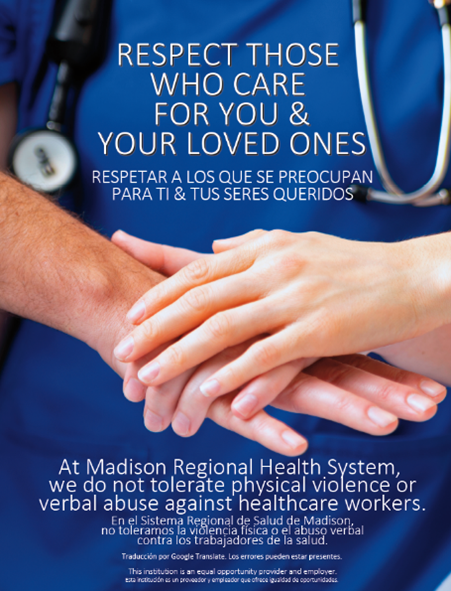Workplace violence in healthcare is a serious concern.
Workplace violence in healthcare is a growing concern.
Did you know that of the victims experiencing trauma from workplace violence in 2020, 76% worked in the healthcare and social assistance industry?
Did you know that healthcare workers are 20% more likely than other workers to experience violence by other employees?
According to the National Institute for Occupational Safety and Health (NIOSH), “Workplace violence is the act or threat of violence, ranging from verbal abuse to physical assaults directed toward persons at work or on duty. The impact of workplace violence can range from psychological issues to physical injury, or even death.” Workplace violence in healthcare can involve episodes between staff members but also includes violence directed at staff from patients and families.
Your SDAHO Quality Team is hearing reports of increased workplace violence within our member facilities. Because of this, we wanted to provide you with some resources to assist you and your staff in combating this issue.
In January 2022, The Joint Commission set workplace violence standards to create a safer work environment. Safer work environments lead to better patient care, increased job satisfaction, less turnover and decreased cost. Highlights of those standards include:
- Agree as an organization on what workplace violence means and includes.
- Action cannot be taken until everyone is on the same page. This also helps others understand what should be reported and what will not be tolerated.
- Establish a culture of safety, starting with a reporting system that is easily accessible to staff.
- This will encourage reporting and allow the gathering of usable data, specific to the organization.
- Build a team to assist in creating policies and procedures.
- Input from multiple employees and disciplines within the organization is important as everyone will not have the same experiences or perspectives.
- Deploy hospital-wide training and resources.
- This should reach all staff, including new hires and on a continued basis to support non-tolerance of workplace violence within the organization.
- Annually review the workplace violence prevention program within the organization to maintain integrity and update as needed.
According to the American Nurses Association’s (ANA) 2019 survey, 1 in 4 nurses report being physically assaulted. This statistic comes with the realization that workplace violence is also underreported.
Taking action on workplace violence establishes a message to all that threats or incidents of workplace violence are a priority and will not be tolerated. Madison Regional Health System in Madison, SD has taken a simple step to show just this. They have displayed posters within the facility stating that workplace violence will not be tolerated. “Employee safety is a top priority at Madison Regional Health System. We have posters displayed in every room in the ER, on our electronic frames at each admission desk, and on the wall upon entry to the med/surg floor. We feel that the posters are a simple, effective visual that conveys a message of support for all staff.” Amber Oines, Quality Nurse Specialist and Kathy Hansen, Director of Quality/Safety/Emergency Preparedness with Madison Regional Health System.
Workplace violence in healthcare is an alarming concern. Has your facility taken action?
Workplace Violence Prevention Resources:
- NIOSH Workplace Violence Prevention Course for Nurses (FREE)
- Toolkit for Mitigating Violence in the Workplace
- https://www.nursingworld.org/practice-policy/work-environment/end-nurse-abuse/
- End Nurse Abuse Campaign
- IHI Preventing Verbal and Physical Violence Across the Health Care Workforce Toolkit
- Nurse Safety Checklist
Additional References:





